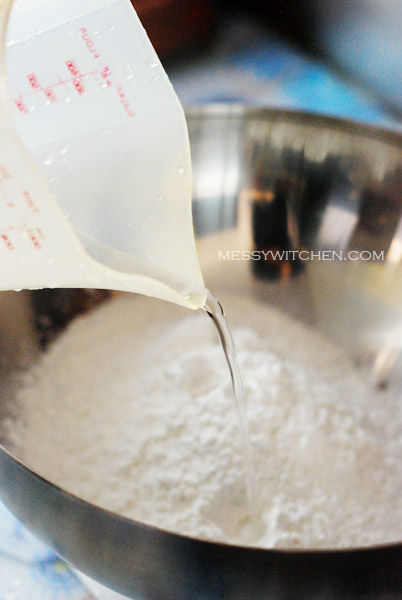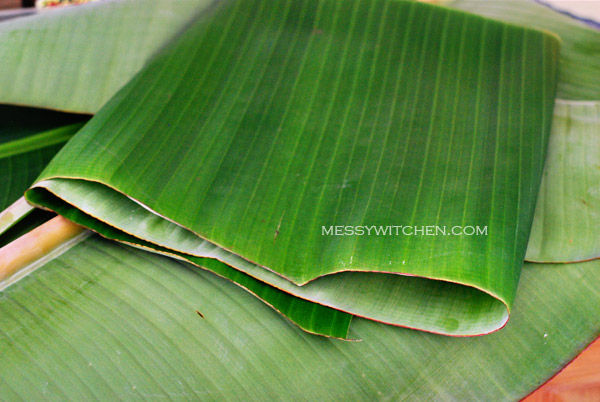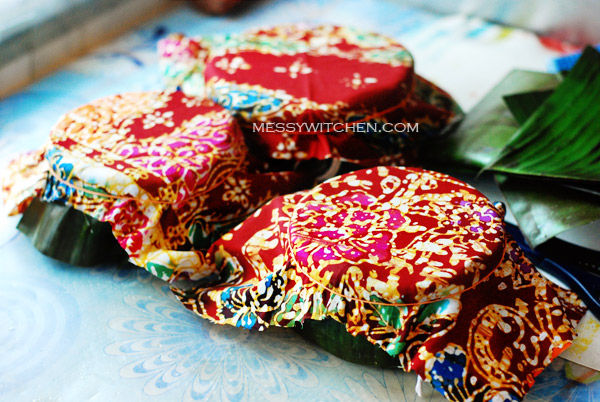Nian Gao is a Chinese New Year food with many names. Let’s see… nian gao 年糕, ti kuih 甜粿 (called by the Hokkien and Peranakan), sweet sticky rice cake, kuih bakul (called by the Peranakan I guess and Malay), Chinese new year’s cake, year cake and rice cake. Fhewww! Since I’m Hokkien, I call it ti kuih (sweet cake). Literally nian gao means year cake. The sound of nian gao however echoes the sound of 年高 (year higher) which means rising abundance/prosperous or higher achievement for the coming year.
 1.jpg)
Besides offering ti kuih during CNY’s eve and pai tee kong (prayer to God of Heaven-Jade Emperor on the 8th night of Chinese New Year), ti kuih is also offers to the Kitchen God (about a week before CNY) so that his mouth is full of sticky cake hence he’s unable to badmouth the human family and also as a bribe (to sweeten him) so that he will give favorable report to God of Heaven when he returns to heaven. We don’t have Kitchen God in our kitchen. However my paternal grandma worshiped the Kitchen God and I’ve seen her offering ti kuih, oranges and joss sticks to the Kitchen God.
Making ti kuih involves 3 simple ingredients however it takes a VERY long time to cook. Hence I guess that’s why most newer/modern recipes call for the use of brown sugar and/or caramelized sugar to shorten the steaming time. The ti kuih recipe I’m sharing uses the old traditional Straits Chinese-Peranakan method (READ: Involves 10-12 hours of steaming) Hehe Did I just give you a heart attack? Hehe don’t worry, I had a mild one too when I first scan the recipe. I know the long steaming hours seem daunting but I assure you it is not and the outcome of the homemade ti kuih will make you feel very proud and happy. Not to mention the smell of the caramelized sugar (after long hours of steaming) is a wonderful way to make the house smell like sugar factory. Haha
 2.jpg)
Now what prompted me to make ti kuih this year is because I was horrified at the cost of ti kuih. It’s about RM10-12 a piece for say a medium size ti kuih. How do you justified the cost? Ingredients are simple and cheap. Of course steaming method is long if using the traditional way but still… So I told my mom I’ll make some for her this year.
Ok I know I talked too much already. Let’s get started!

Combine glutinous rice flour and water.
Btw I’ve seen a recipe using glutinous rice flour and tang flour (tang mien fun) together. Anyone know what is the effect of using tang flour in ti kuih?

Mix to become a thick batter-dough. Then, add sugar. Mix until sugar dissolves.
At this point I was wondering how am I suppose to add sugar next since the mixture resemble a dough!
Surprisingly as I mix in the sugar, the dough mixture turn into liquid. Woo! Anyone is good in chemistry? Care to explain why? I’m kinda dumb. Haha Update: I found the answer myself: osmotic pressure. Yes it can happen even if the sugar is ‘solid’.

Ti kuih batter. Leave it aside while you get ready the banana leaf and container.
Tsk, some recipe call for the use of oil. Maybe one of the reason is to glisten the surface of Ti Kuih and the 2nd reason is so that you will find it easy to remove the cake from tin later (I guess). Can anyone enlighten me on this?

Banana leaf which I got from my Indian neighbor. Blanch banana leaf to soften it. One of the pro of having Indian neighbor. 🙂 And the leaf is as tall as me! Healthy tree… kekeke
If you cannot find banana leaf, sub it with glass paper (also known as cellophane paper).

Line the tins (circumference and base) with three layers of banana leaf. Leave enough leaf to extend above the tin so that it can be folded back around the rim of the tin. Tie with string or rubber bands.
I’m using tiffin carrier container as the tin (12-14cm diameter-not a good idea actually). Not gonna share how I cut the banana leaf and fit into the tin cause my attempt was unsuccessful. The result was kinda ugly. I’ll experiment more later and perhaps share with you the right way in my future post.

Next pour batter into the lined tins until 3/4.

Then cover the top with muslin cloth to prevent vapour/water dripping into the cake. Secure the cloth with string or rubber bands.
I used batik cloth as I don’t have muslin cloth. You can use any white cloth or aluminium foil I think. The pro of using rubber bands here is that you can open the top easily to look at the condition of the cake compared to using string but rubber band will be less elastic as the steaming time gets longer. So prepare some extra rubber bands on hand. Not a problem actually, just FYI.
In high heat, steam for 10-12 hours, or until ti kuih is golden brown. I actually steam the Ti Kuih in low heat. The only thing you need to do during the 10-12 hours steaming is to make sure the steamer has enough water.
For my case, 5 hours into steaming, the batter changes from white into light brown color. Then later it changes into golden brown color (caramelized sugar). I steamed my ti kuih for 10 hours.
Finally allow the ti kuih to set overnight (best if you leave it for 2-3 days) before removing them from the tins. Trim off the leaf to get neat edges. Allow ti kuih to harden slightly (about a week) before cutting for consumption. That’s it! Easy peasy right? 😛 Hehehe
 3.jpg)
What do you do with ti kuih after offering it to the Gods? Usually, it will end up sitting in a corner of the house until it gets moldy whereby it’ll end up in the bin. Why not try my Grandma’s fried ti kuih with yam & sweet potato recipe? Making fried ti kuih is an age-old tradition in Chinese households. We’ve been guilty of throwing moldy ti kuihs away. Not anymore. Time to embrace it!
Chinese New Year Ti Kuih (Nian Gao-Sweet Sticky Rice Cake-Kuih Bakul)
Adapted from Nyonya Flavours.
Yields 3 cakes.
400g glutinous rice flour
400ml water
500g sugar
1 banana leaf
3-4 round tins (8cm-10cm diameter, 10cm height)
cotton string or rubber bands
Method:
1. In a large mixing bowl, add rice flour and water. Mix to form a thick batter-dough. Add sugar and mix until sugar dissolves. Place aside.
2. Blanch banana leaf to soften it. Line the tins with three layers of trimmed banana leaves. Leave enough leaf to extend above the tin so that it can be folded back around the rim of the tin. Tie with string or rubber bands. If you’re unable to find banana leaf, you can substitute with glass paper (also known as cellophane paper).
3. Pour batter into lined tins to about 3/4. Then cover the tins with muslin cloth to prevent vapour/water dripping into the cake. Secure with string or rubber bands. Note: I used batik cloth here (make sure it doesn’t stain) or I guess you can use any white cloth or aluminium foil.
4. In high heat, steam for 10-12 hours, or until ti kuih is golden brown in color. Tsk I steamed the ti kuih with low heat. Remember to add water to steamer from time to time.
5. Let the ti kuih to set overnight (best if you can leave it for 2-3 days) before removing from the tins. Trim the leaf at the edge for neater look. Allow ti kuih to harden slightly for a week before cutting.
Note: Ti kuih can last a couple of months at room temperature or more in the refrigerator.
Do not throw away molded ti kuih. Just wipe with a clean dry cloth. This is a norm for my family. Haha
Serving suggestions:
1. Slice and serve.
2. Cut into small pieces (3cm), steam until soft and coat with freshly grated coconut to which a little salt has been added).
3. Cut into pieces, sandwich between slices of taro and/or sweet potato, dip in batter and deep fried until golden and crispy. Follow my grandma’s recipe.
Good luck with the steaming!




14 Comments
Thanks for sharing. I made nian goa today. Usually I would used brown sugar but today I used white sugar. I was horrified to see that after steaming it for nearly 2 hours and my nian has hardened, it was still white! So now I know that Im supposed to steam it for a very long period of time.
Hi Ledia,
It’s a pleasure to share with everyone. Mine turned into light brown after about 4-5hours of steaming and then into deeper brown later.
Hi! What is Tang Mien Flour? Can you give me the chinese character? Thanks!
Hi Kayenne, in English it’s called wheat flour. I googled for the Chinese name… come up with ‘cheng fen’ – 澄粉. Not sure correct or not.
I think you meant Wheat Starch – not flour? Wheat flour is the regular flour we use for breads, cakes and cookies. Wheat starch is like flour, but with the gluten/protein removed.
If the same, wheat starch is also used in some fried sesame balls to make it springier, aside from stabilizing the dough, to keep the ingredients from separating. I think it is also used in mochi. First time I’ve read it added to nien gao also… but I’ll ask someone who makes to try – do you remember how much is added?
Thanks!
Hi Kayenne, yes I think you are right. It’s wheat starch. I don’t remember where I saw it. Maybe you can google tang mien fun and nian gao together to get the recipe.
Can I bake the finished nian gao instead of frying it? Trying to stay healthy during CNY~
Hi Angel, I’m not sure as I’ve never tried baking nian gao.
So happy to find your ti kuih recipe. Was looking for a traditional recipe just like what my grandmother used to. I always remember that she steam the kuih thru the night. . Will definitely make it this year. Have to keep this tradition alive! Thank you for sharing so generously.
Hi Cindy, you’re welcome. 🙂 Hope this recipe is similar to your grandma’s.
Very happy to found your recipe in making Ti Kueh, simple version of recipe than those that needed to add on 澄粉. Thanks for sharing
Hi Eileen, welcome. 🙂
Hi, may i know how much to substitute the sugar for brown sugar? require this for our project and e do not have enough time for long hours of steaming. Thanks in advance!
Hi SF, as I’ve never tried it with brown sugar I’m not able to tell you how much to substitute. I googled for the white sugar to brown sugar substitute and most answer says you can do 1:1 but the taste will be different.